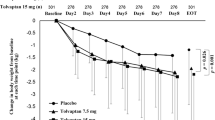Abstract
To verify prospectively the usefulness of the furosemide-induced natriuresis test in predicting ascites control by medical treatment, 15 stable cirrhotics (9 male) with ascites were studied. Sodium excretion was measured after this test and after volume expansion with saline associated with intravenous infusion of octreotide; 6 months later, response to medical treatment was rated as good (N=9) or poor (N=6). Patients with poor ascites control had lower sodium excretion with the furosemide-induced natriuresis test (median, 88 vs 201 mmol; P < 0.01). Poor control was observed in four of four patients with sodium excretion ≤125 mmol, and good control in six of six patients with sodium excretion >175 mmol (P < 0.002). Volume expansion was followed by limited natriuresis (median, 20 mmol), in inverse relationship with plasma active renin concentration (P < 0.001). In conclusion, long-term ascites control is well predicted by the furosemide-induced natriuresis test.

Similar content being viewed by others
References
D’Amico G, Morabito A, Pagliaro L, Marubini E (1986) Survival and prognostic indicators in compensated and decompensated cirrhosis. Dig Dis Sci 31:468–475
Bories P, Garcia Compean D, Michel H, Bourel M, Capron JP, Gauthier A, Lafon J, Levy VG, Pascal JP, Quinton A (1986) The treatment of refractory ascites by the LeVeen shunt. A multi-centre controlled trial (57 patients). J Hepatol 3:212–218
Spahr L, Villeneuve JP, Tran HK, Pomier-Layrargues G (2001) Furosemide-induced natriuresis as a test to identify cirrhotic patients with refractory ascites. Hepatology 33:28–31
Runyon BA (2004) Management of adult patients with ascites due to cirrhosis. Hepatology 39:841–856
Perez-Ayuso RM, Arroyo V, Planas R, Gaya J, Bory F, Rimola A, Rivera F, Rodes J (1983) Randomized comparative study of efficacy of furosemide versus spironolactone in nonazotemic cirrhosis with ascites. Relationship between the diuretic response and the activity of the renin-aldosterone system. Gastroenterology 84:961–968
Wang SS, Lee FY, Wu SL, Hwu CM, Chien CH, Lee SD, Tsai YT, Chao Y, Chen CC, Wang PS (1997) Effects of long-term administration of octreotide on sodium retention and atrial natriuretic peptide in carbon tetrachloride-induced cirrhotic rats. J Hepatol 26:1128–1134
Moller S, Brinch K, Henriksen JH, Becker U (1997) Effect of octreotide on systemic, central, and splanchnic haemodynamics in cirrhosis. J Hepatol 26:1026–1033
Guevara M, Gines P, Fernandez-Esparrach G, Sort P, Salmeron JM, Jimenez W, Arroyo V, Rodes J (1998) Reversibility of hepatorenal syndrome by prolonged administration of ornipressin and plasma volume expansion. Hepatology 27:35–41
Kubba AK, Dallal H, Haydon GH, Hayes PC, Palmer KR (1999) The effect of octreotide on gastroduodenal blood flow measured by laser Doppler flowmetry in rabbits and man. Am J Gastroenterol 94:1077–1082
Ottesen LH, Flyvbjerg A, Jakobsen P, Bendtsen F (1997) The pharmacokinetics of octreotide in cirrhosis and in healthy man. J Hepatol 26:1018–1025
Satta A, Faedda R, Chiandussi L, Bartoli E (1983) Fluid and electrolytes in liver disease. Postgrad Med J 59(Suppl 4):64–72
Romano G, Favret G, Federico E, Bartoli E (1998) The site of action of furosemide. Pharmacol Res 37:409–419
Lubetsky A, Winaver J, Seligmann H, Olchovsky D, Almog S, Halkin H, Ezra D (1999) Urinary thiamine excretion in the rat: effects of furosemide, other diuretics, and volume load. J Lab Clin Med 134:232–237
Gentilini P, Romanelli RG, Laffi G, Barletta G, Del Bene R, Messeri G, La Villa G (1999) Cardiovascular and renal function in normotensive and hypertensive patients with compensated cirrhosis: effects of posture. J Hepatol 30:632–638
Schwartz JB (2003) Gender-specific implications for cardiovascular medication use in the elderly optimizing therapy for older women. Cardiol Rev 11:275–298
Author information
Authors and Affiliations
Corresponding author
Rights and permissions
About this article
Cite this article
Toniutto, P., Pirisi, M., Fabris, C. et al. The Significance of the Furosemide Test for Predicting Ascites Control by Diuretics in Cirrhotics: A Comparison with Volume Expansion and Octreotide Infusion. Dig Dis Sci 51, 1992–1997 (2006). https://doi.org/10.1007/s10620-005-9072-2
Received:
Accepted:
Published:
Issue Date:
DOI: https://doi.org/10.1007/s10620-005-9072-2




